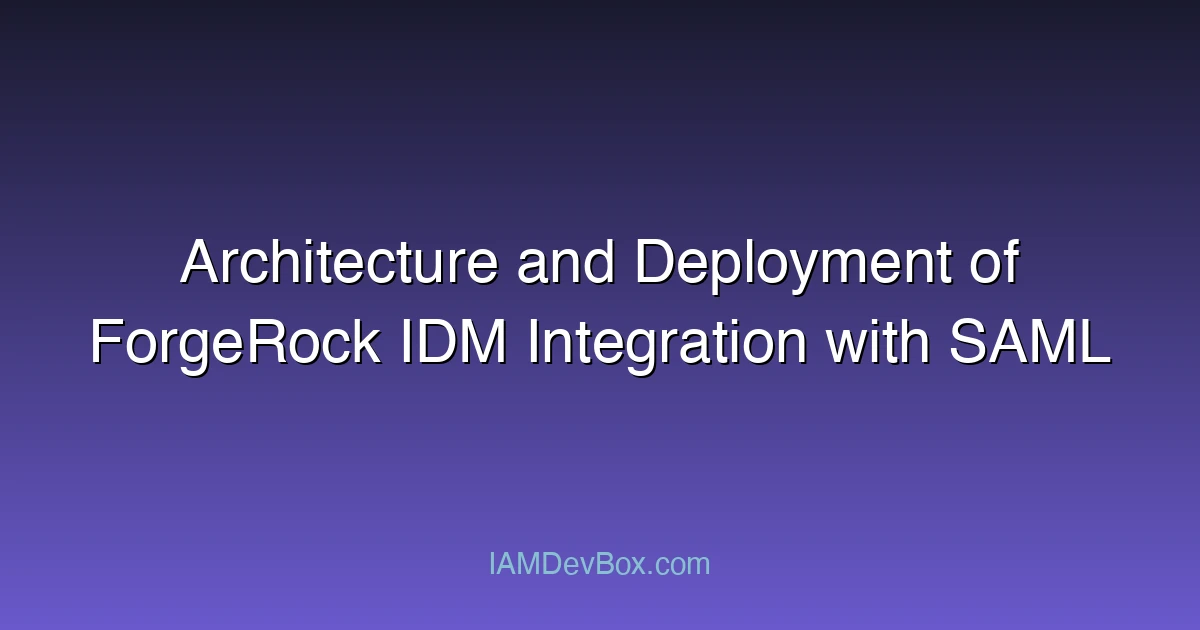In today’s interconnected digital landscape, seamless identity management and secure authentication are critical for businesses. ForgeRock Identity Management (IDM) is a leading solution for managing user identities and access across various systems. Integrating ForgeRock IDM with Security Assertion Markup Language (SAML) extends its capabilities, enabling Single Sign-On (SSO) and Federation with external service providers. This blog post delves into the architecture and deployment considerations for this integration.
Visual Overview:
sequenceDiagram
participant User
participant SP as Service Provider
participant IdP as Identity Provider
User->>SP: 1. Access Protected Resource
SP->>User: 2. Redirect to IdP (SAML Request)
User->>IdP: 3. SAML AuthnRequest
IdP->>User: 4. Login Page
User->>IdP: 5. Authenticate
IdP->>User: 6. SAML Response (Assertion)
User->>SP: 7. POST SAML Response
SP->>SP: 8. Validate Assertion
SP->>User: 9. Grant Access
Introduction to ForgeRock IDM and SAML
ForgeRock IDM is a powerful platform designed to manage user identities, roles, and access across enterprise applications. It provides robust features for user provisioning, deprovisioning, and lifecycle management. SAML, on the other hand, is an XML-based standard for exchanging authentication and authorization data between parties—commonly referred to as Identity Providers (IdP) and Service Providers (SP).
Integrating ForgeRock IDM as an IdP with SAML allows organizations to enable SSO for users accessing multiple applications. This integration streamlines user experience and enhances security by centralizing identity management.
Architecture Overview
The architecture of ForgeRock IDM integration with SAML involves the following key components:
- ForgeRock IDM as the Identity Provider (IdP): ForgeRock IDM authenticates users and issues SAML assertions containing user identity and attributes.
- Service Provider (SP): The external application or system that consumes the SAML assertions to grant access to users.
- SAML Metadata: Exchange of metadata between IdP and SP to establish trust and configuration details.
- User Federation: The process of federating user identities between ForgeRock IDM and external systems.
Diagram: High-Level Interaction Flow
flowchart LR
N0[User] --> N1[ForgeRock IDM (IdP)]
N2[External SP] --> N3[User Access]
style N0 fill:#667eea,color:#fff
style N3 fill:#48bb78,color:#fff
Technical Architecture
1. ForgeRock IDM Configuration
To configure ForgeRock IDM as an IdP, the following steps are essential:
- SAML Profile Setup: Define the SAML profile in ForgeRock IDM to specify the type of SAML interaction (e.g., Browser SSO Profile).
- Metadata Exchange: Export ForgeRock IDM’s metadata and import the SP’s metadata to establish trust.
Example: ForgeRock IDM SAML Configuration
<ProfileConfig>
<Name>urn:oasis:names:tc:SAML:2.0:profiles:SSO:browser</Name>
<Description>Browser SSO Profile for SAML 2.0</Description>
<Configurations>
< Issuer >example.com</ Issuer >
<SignatureAlgorithm>SHA256withRSA</SignatureAlgorithm>
<NameIDFormat>urn:oasis:names:tc:SAML:2.0:nameid-format:emailAddress</NameIDFormat>
</Configurations>
</ProfileConfig>
2. Service Provider Configuration
The SP must be configured to consume SAML assertions from ForgeRock IDM. Key configurations include:
- IdP Metadata Import: Import ForgeRock IDM’s metadata into the SP.
- SAML Endpoints: Configure the SP to use the appropriate SAML endpoints (e.g., Single Sign-On Service URL).
Example: SP Metadata Configuration
<md:EntityDescriptor entityID="https://sp.example.com">
<md:SPSSODescriptor protocolSupportEnumeration="urn:oasis:names:tc:SAML:2.0:protocol">
<md:SingleSignOnService Binding="urn:oasis:names:tc:SAML:2.0:bindings:HTTP-Redirect" Location="https://sp.example.com/saml2/sso"/>
<md:KeyDescriptor use="signing">
<ds:KeyInfo xmlns:ds="http://www.w3.org/2000/09/xmldsig#">
<ds:X509Data>
<ds:X509Certificate>MIIC...base64certificate...</ds:X509Certificate>
</ds:X509Data>
</ds:KeyInfo>
</md:KeyDescriptor>
</md:SPSSODescriptor>
</md:EntityDescriptor>
3. User Federation
User federation involves mapping user identities from ForgeRock IDM to the SP. This is achieved by defining attribute mappings in the SAML profile to include necessary user attributes (e.g., username, email, roles).
Example: Attribute Mapping in ForgeRock IDM
{
"name": "SAML_Attributes",
"description": "SAML Attribute Mapping",
"attributes": [
{
"name": "email",
"value": "${user.userName}"
},
{
"name": "role",
"value": "${user.role}"
}
]
}
Deployment Considerations
1. Planning and Design
- Use Case Analysis: Understand the specific requirements for SAML integration (e.g., SSO, Federation).
- Trust Relationship: Establish a secure trust relationship between ForgeRock IDM and the SP.
2. Environment Setup
- Certificate Management: Use strong certificates for signing and encryption.
- Network Configuration: Ensure proper firewall rules and network access for SAML endpoints.
3. Configuration and Testing
- Metadata Exchange: Verify the exchange of metadata between IdP and SP.
- End-to-End Testing: Test the entire user flow to ensure seamless SSO and Federation.
4. Monitoring and Maintenance
- Logging and Monitoring: Implement logging for SAML interactions and monitor for anomalies.
- Regular Updates: Keep ForgeRock IDM and SP software updated to address security vulnerabilities.
Example Flow: User Authentication with SAML
- User initiates login: The user accesses the SP application.
- SP redirects to IdP: The SP redirects the user to ForgeRock IDM for authentication.
- User authenticates: The user provides credentials to ForgeRock IDM.
- SAML assertion issued: ForgeRock IDM issues a SAML assertion containing user attributes.
- SP processes assertion: The SP validates the assertion and grants access to the user.
Benefits of the Integration
- Enhanced Security: Centralized identity management and secure SAML assertions.
- Improved User Experience: Seamless SSO across applications.
- Scalability: Supports large-scale deployments with multiple SPs.
Challenges and Solutions
-
Token Validation: Ensure proper validation of SAML assertions to prevent replay attacks.
- Solution: Implement time-based constraints and unique identifiers in assertions.
-
Metadata Synchronization: Maintain up-to-date metadata between IdP and SP.
- Solution: Use automated metadata exchange mechanisms.
🎯 Key Takeaways
- SAML Profile Setup
- Metadata Exchange
- IdP Metadata Import
Conclusion
Integrating ForgeRock IDM with SAML is a powerful way to enhance identity management and enable seamless SSO across applications. By carefully planning the architecture, configuring the components, and monitoring the deployment, organizations can achieve a secure and scalable identity management solution.
If you have any questions or need further assistance, feel free to reach out!
FAQs
- How does SAML integration enhance user authentication in ForgeRock IDM?
- What are the key considerations for securing SAML assertions in a production environment?
- Can the ForgeRock IDM SAML integration support multi-factor authentication?
Meta Description
Learn about the architecture and deployment strategies for integrating ForgeRock IDM with SAML, enabling Single Sign-On and Federation capabilities.
